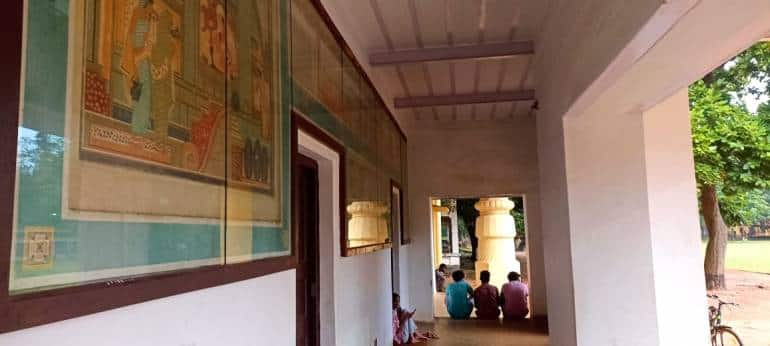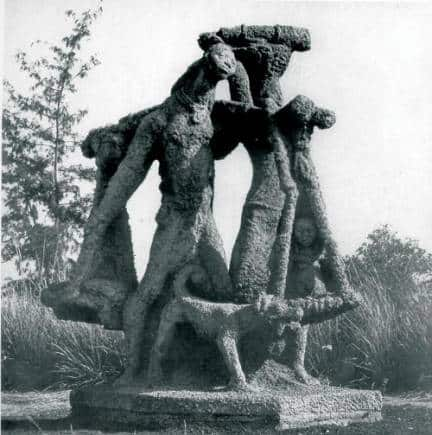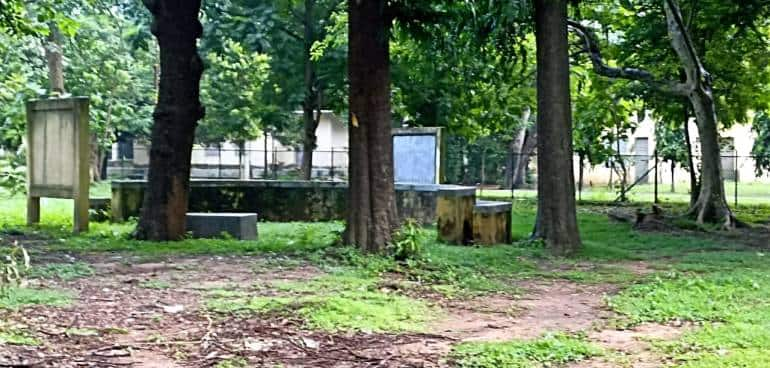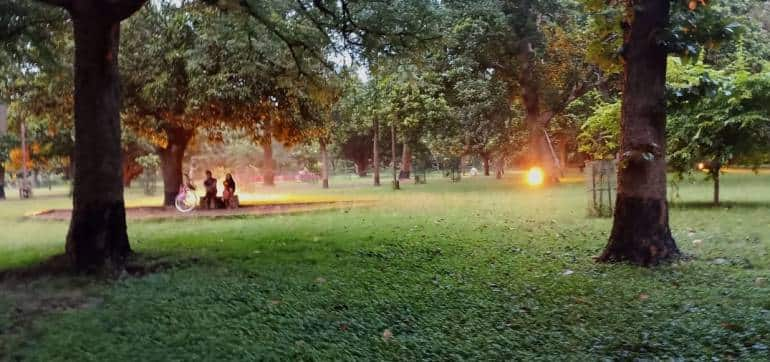



At the large glass-fronted Tagore Tiles and Sanitary Ware shop near the Bolpur bus stand and a short distance from Santiniketan, I had once happened to ask an employee whether the Tagore reference in the shop’s name helps sell more of the tiles, basins, sinks and commodes. I should have been more discreet; the guy seemed lightly affronted. “Arre dada, Tagore is ubiquitous. He is present in every moment of our lives.”
Evidently. Tagore is there in Kabiguru Sanitary and Plumbing in Santiniketan’s Ratanpally, he is in Tagore Optical Centre; he is there on stickers plastered on those dreadful DJ boxes at Gitanjali Sound; or in the interiors of the garishly luminescent Gitanjali Hotel. He is there in the umbra of Robichaya Handicraft and in Dhaba Robindro Chayatol, even 20-odd km ahead of Santiniketan. Hello, he is even present in every bite when customers dig into the momos at Hridaye Momo, whose name is a clever play on a line from a Tagore song. Clearly the guy at Tagore Tiles and Sanitary Ware had a point.
 A concert at the Nabanna festival in Santiniketan. (Photo: Shamik Bag)
A concert at the Nabanna festival in Santiniketan. (Photo: Shamik Bag)
I was there at the store looking for floor tiles for a house that I was then building in the formidable shadow of Tagore and his Santiniketan, the quaint town in Bengal’s Birbhum district about 160 km from Kolkata that was born, nurtured and continue to survive along with the Tagore-founded Visva-Bharati University. That the appeal of Santiniketan, including Visva-Bharati — envisaged as an academic and aesthetic pact between the world and India — is universal was further exemplified recently with the United Nations Educational, Scientific and Cultural Organization (UNESCO) bestowing its prestigious World Heritage site tag on Tagore’s town and institution on September 17.
 Nandalal Bose's paintings at Patha Bhavan office, Visva-Bharati, Santiniketan. (Photo: Shamik Bag)
Nandalal Bose's paintings at Patha Bhavan office, Visva-Bharati, Santiniketan. (Photo: Shamik Bag)
‘It is an ensemble of historic buildings, landscapes and gardens, pavilions, artworks, and continuing educational and cultural traditions that together express its Outstanding Universal Value’ is how UNESCO describes the latest entrant to the World Heritage Site list. ‘Santiniketan is also directly and tangibly associated with the ideas, works and vision of Rabindranath Tagore and his associates, pioneers of the Bengal School of Art and early Indian Modernism. This UNESCO recognition not only celebrates India's heritage but also reinforces the global significance of Santiniketan as a cultural and educational beacon,’ the commendation adds.
 The road leading towards Santiniketan. (Photo: Shamik Bag)
The road leading towards Santiniketan. (Photo: Shamik Bag)
My own relationship with the Nobel Laureate has been nebulous by any measure, my mind rebelling possibly against the Tagore overkill of my childhood. Growing up in Kolkata in a determinedly Tagore-obsessed Bengali family, Tagore’s songs — Rabindrasangeet, his prose, verse and plays were an inevitable presence in family functions. Outside, on socio-religious occasions like Durga Puja, loudspeakers blared his songs non-stop; the Mamata Banerjee government in Bengal, after coming to power in 2011, going a step further by deciding to play Rabindra Sangeet at Kolkata traffic signals. He was everywhere — in school text; on television and the big screen, where films based on his work played; on giant hoardings; his verse part of political wall graffiti; his name lent to Metro stations, stadiums, auditoriums, streets, lakes, bridges, and hospitals. There was even a government proposal to change the name of north Kolkata’s Nimtala burning ghat, where the poet-polymath-philosopher was cremated in 1941 — the morbid symbolism of the suggestion notwithstanding.
Playing the role of the protagonist Amal, the ailing little orphan boy forced to remain indoors but craving for the world passing by his window, in Tagore’s play Dak Ghar (The Post Office), for a theatre production by my paternal aunt, my six-year-old self rebelled on stage at my sister’s overzealousness as a prompter — her prompting a buzzing mosquito-like drone to my dialogue delivery. “Can you then keep quiet, didibhai?” I raged loudly in between a dialogue, much to the mirth of the audience. Was it the story of a little kid confined to a room, or was it an early understanding of the universe of Tagore confined to small rooms and boxes within Bengali society, that made Amal in my aunt’s play break out in unscripted anger? Tagore, by most accounts, defied deification. He might have approved, I felt with the coming of the first greys streaking my hair.
 At the Patha Bhavan office, Visva-Bharati, Santiniketan. (Photo: Shamik Bag)
At the Patha Bhavan office, Visva-Bharati, Santiniketan. (Photo: Shamik Bag)
While acting on a suggestion of my mother, who had just retired after 25 years of service and who sought an alternative to our concrete-clogged city living, we quickly zoomed in on a patch in a largely-Santhali tribal village about 20 minutes driving distance from Santiniketan. The house I went on to build with my life’s savings as a journalist-writer (‘every brick here is a word I wrote and got paid for,’ I often find myself describing to visitors) is more of an opening to the world outside, I’d like to believe.
 My abode, my own shanti niketan, in Santiniketan, West Bengal. (Photo: Shamik Bag)
My abode, my own shanti niketan, in Santiniketan, West Bengal. (Photo: Shamik Bag)
Moonbeam filters in through skylights above, translucent fibreglass allows diffused sunlight allowing indoor plants to prosper; all windows are large enough to double up as doors and vice-versa; Birbhum’s fixative and cooling mud instead of cement glues the bricks together; indigenous dry straw matting under terracotta roof tiles provide natural insulation; the shape of the house itself is a cross between the traditional Bangla-style of architecture with its inverted boat-hull-like slanting roof and western creature comforts; and, everywhere you see it's only the green of the 100-plus trees I have planted. For the past three years, we, including our three dogs, Gooblet, Kutlet and Lady Mamlet, have lived immersed in nature and all its offerings — fruits and flowers, butterflies, worms, insects, birds, bees, squirrels, langurs, chameleons, rats, mice, termites and the occasional snake. Well over a hundred friends and family members have stayed under its roof.
 The canine residents of my house, (from left) Kutlet, Lady Mamlet and Gooblet with my mother. (Photo: Shamik Bag)
The canine residents of my house, (from left) Kutlet, Lady Mamlet and Gooblet with my mother. (Photo: Shamik Bag)
The framed prints of Tagore’s paintings are a dead giveaway to my current disposition. Looking deeper, in the openness and inclusivity of the house, I have found communion with Tagore’s vision — my kind of abode of peace, a shanti niketan within Santiniketan.
The university town itself has welcomed the outsider with a warm, welcoming embrace. Village neighbours and friends have come along bearing gifts like home-grown fruits and vegetables; one rang the bell at 6 am with the fresh catch off the family pond, while a Santhali construction worker brought a bottle of the tribal intoxicant brewed at his home, a bottle of delightful mahua. We have had countless nightlong music sessions; winter fires, barbeques and outdoors cooking; stayovers reminiscent of college life; swam in the Kopai and Ajoy rivers; bicycled through Birbhum’s forested red laterite terrain; shared the transcendental rustic charm of many baul music festivals, and true to Santiniketan’s off-the-grid character, been on weekday-workday picnics.
Santiniketan has also introduced itself through its eccentrics — city-born people who forsook electricity for much of their lives to be able to blend in with the surrounding tribal and rural life; have built houses with no road access; foreign visitors and students who never left; and those who are painstakingly going back to the roots of grounded, sustainable living.
 The police outpost, too, at the Sonajhuri Haat area bears colourful decorative motifs. (Photo: Shamik Bag)
The police outpost, too, at the Sonajhuri Haat area bears colourful decorative motifs. (Photo: Shamik Bag)
The aesthetics is there in the carelessly strewn about public art, often by students of Kala Bhavana — the globally renowned centre for study in visual art and research in Visva-Bharati founded by Tagore in 1919–whose paintings and sculptures adorn walls of nondescript eateries, student hostel verandahs, and in public venues like the Sonajhuri Haat area. Originally meant as a Saturday fair for handicraft and art items to be sold by the maker herself within the shade of a charming forest of shonajhuri trees, the haat is now a popular everyday affair. Visitors from Kolkata and from the rest of India and abroad come in droves and return with lighter wallets and heavier bags of goodies. Even the police outpost at the haat bears colourful decorative motifs. Arms entwined, Bengali ladies try to match steps with leaden feet alongside Santhali women dancers accompanied by the addictively percussive rhythm of the madol and dhamsa. Shonajhuri Haat, for many of its disgruntled founders these days, is a brazen tango between ostentatious culture and unpretentious commerce.
It wasn’t always so. In the 1975-shot incomplete documentary film on one of Tagore’s favourite artists and former student who became head of Kala Bhavana’s sculpture department, Ramkinkar Baij: A Personality Study, filmmaker Ritwik Ghatak quizzes Baij on the reason behind the legendary sculptor-painter using his large canvas oil paintings to stop rainwater seeping through into this room from a leaking roof. But Baij is worried: an exhibition is coming up for which the paintings have to be brought down from the roof. ‘What will hang in their place?’ Baij wonders to his own merriment.
 'The Santhal Family', artist Ramkinkar Baij's ten feet tall sculpture installed in Santiniketan in 1939, is considered the country's first outdoor sculpture about ordinary people. (Photo: Courtesy of Visva-Bharati)
'The Santhal Family', artist Ramkinkar Baij's ten feet tall sculpture installed in Santiniketan in 1939, is considered the country's first outdoor sculpture about ordinary people. (Photo: Courtesy of Visva-Bharati)
Baij’s work can be seen through towering sculptures like The Santhal Family, Mill Call and Sujata, installed inside the premises of Visva-Bharati and along the road running past Teen Pahar, the decorously lit giant banyan tree under which Tagore’s father, Debendranath Tagore who first bought land here in 1863, spent evenings meditating; and the gorgeous coloured glass house, Upashona Griho, used till date for non-denominational prayers and songs.
The road leading towards Sriniketan, where Tagore based the lesser-known but significant rural reconstruction and agricultural wings of Visva-Bharati, is further fringed on both sides by Uttarayan Complex, which is an exposition of the unique crossover architectural heritage of Santiniketan, including the Tagore museum and five separate houses used variously by the poet to reside; and Kala Bhavana and the Santiniketan Bari, the first house to come up there and where a young Tagore also lived. Yet, another of Baij’s sculptures, Anirban Sikha, stands in front of the two-storied building — the contours of the mother-child sculpture, it is said, come alive with the slanted rays of the sun.
It is twilight when we are there in front of the Santiniketan Bari. I’m being guided around the campus by newly-made friends Swati and Banhisikha, both of whom have Visva-Bharati associations through education and work. Also there is Benji, an audio-visual professional, who is proud to belong to the “from KG to PG” category of Visva-Bharati students–those who enrolled in the nursery section of Patha Bhavan, the school that Tagore founded with five students, and went on to complete their post-graduation from the university.
 Patha Bhavan school students heading for the kitchen in an unchaperoned disciplined file, inside the Viva-Bharati campus, Santiniketan. (Photo: Shamik Bag)
Patha Bhavan school students heading for the kitchen in an unchaperoned disciplined file, inside the Viva-Bharati campus, Santiniketan. (Photo: Shamik Bag)
Benji, especially, is excited to hand-hold me through his alma mater. He focuses especially on the Patha Bhavan school precincts, showing me the open-air areas where classes are held and the concrete blocks on which teachers sit, each block often referred to by the teachers name. While classes for Patha Bhavan students continue to be held outdoors in keeping with Tagore’s vision of nature being a mate to a child’s education, small elegant buildings lining the campus act as classrooms during the rainy season.
 Open-air class areas with teacher's bench facing the students' bench. (Photo: Shamik Bag)
Open-air class areas with teacher's bench facing the students' bench. (Photo: Shamik Bag)
 A close-up of another open-air class area in Visva-Bharati, Santiniketan. (Photo: Shamik Bag)
A close-up of another open-air class area in Visva-Bharati, Santiniketan. (Photo: Shamik Bag)
Children, in traditional kurta-pyjama and saris, stream about the campus. From one end, choral singing of a Tagore song floats in with the breeze–rehearsals are on for the ensuing pre-Durga Puja Sarod Utsav. With the moon up in the sky, the four of us climb up the open-air stage at Gour Prangon, which hosts many performances and programmes of Visva-Bharati, for a breather within our walking tour.
 Couples in the Visva-Bharati campus, Santiniketan. (Photo: Shamik Bag)
Couples in the Visva-Bharati campus, Santiniketan. (Photo: Shamik Bag)
All around, in the moody and transitory phase of twilight, are young couples huddled together. Patha Bhavan students, Benji informs. Visva-Bharati University has been going through a lot of changes recently, not all of them welcomed eagerly by current or former students. From its all-inclusive world view, many feel, Visva-Bharati is being led through a tunnel of insularity. Swati is pleasantly surprised that there has been no embargo by the administration on romantic love yet among its students. “My heart is full,” she gushes.
Discover the latest Business News, Sensex, and Nifty updates. Obtain Personal Finance insights, tax queries, and expert opinions on Moneycontrol or download the Moneycontrol App to stay updated!
Find the best of Al News in one place, specially curated for you every weekend.
Stay on top of the latest tech trends and biggest startup news.